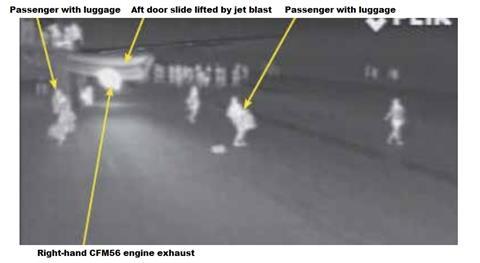Passengers risked being sucked into the operating engine of a Lauda Airbus A320 after commencing an unnecessary evacuation of the aircraft at London Stansted, investigators have determined.
The aircraft (OE-LOA) suffered a contained failure of its left-hand CFM International CFM56 powerplant during the take-off roll on 1 March last year.
Its crew rejected the take-off and brought the jet to a halt, before instructing the cabin crew to take their stations.
After the failed engine was secured by the pilots they correctly decided to vacate the runway under the power of the right-hand engine.
“The crew were subsequently surprised to see a cabin door open, a slide deployed and passengers walking in front of the aircraft,” says the UK Air Accidents Investigation Branch.
Even at idle thrust, jet exhaust blew over a number of passengers evacuating from the right-hand overwing exits, while the captain noticed some passengers were heading in the direction of the engine inlet.
“Had any of them entered the right engine’s inlet suction danger area, it is possible that they could have been sucked into the engine,” says the inquiry. The engine was shut down about 2min after the pilots noticed the first door – the forward left-hand exit – had been opened.
“Once they had noticed that an evacuation had commenced there was realistically no way that the flight crew would have been able to recover the situation,” the inquiry adds.
It says 10 occupants received minor injuries during the event but points out that the injuries could have been more serious.

Investigators believe a number of events served to “overwhelm” the senior flight attendant, prompting her to order the evacuation over the public-address system.
She had become focused on the aircraft sounds and movement after being startled by the noise of the engine failure, and did not hear the pilots’ command to take stations. The other cabin crew members did hear the command, but were not aware that the senior attendant had not.
Communication between the cabin crew was attempted with a combination of the public-address system, interphone, shouting and gestures, says the inquiry, with both German and English languages being used.
The use of gestures was ineffective because the cabin lights had been dimmed for the night-time take-off, and the low visibility meant the senior attendant could not see that an interphone had been knocked from its cradle, delaying its use.
These communication problems meant she could not establish whether the situation at the rear of the aircraft was safe.
Under pressure from not having heard the cockpit command and the alarmed passengers, and believing the other cabin crew members were scared, the senior attendant ordered the evacuation – just 1min 20s after the ‘station’ command.
None of the cabin crew contacted the cockpit during this period. But the inquiry says those who had heard the ‘station’ command would have understood the procedure to wait.
“The [senior attendant] had not heard this command but it did not occur to her to contact the pilots,” the inquiry says. “As well as her emotional state, this may have been partly because her interactions with them were so limited under normal circumstances.”
Investigators also point out that training and experience weaknesses might have contributed to the situation. The senior attendant had been promoted to the role after a relatively short time, and her flying career had been interrupted by company bankruptcy – all of which meant she did not meet the carrier’s requirements for operational experience before promotion.
The inquiry says she was part of a large group during cabin crew training, which might have led to certain issues not being fully understood at the time.
“Pressure to have staff operationally available for flights after the bankruptcy and change of operator meant that the subsequent training for [senior attendants] was purely theoretical and short in comparison to the operator’s more recent practice,” it adds.
“These factors may have meant that the [senior attendant] was not well prepared for her role in the emergency.”
Lauda has taken several steps to improve processes in the aftermath of the incident, including an instruction for cabin crew to attempt cockpit contact prior to ordering an evacuation.
It has also enhanced training – including producing a video on rejected take-off procedures – and capped attendance on training courses. The carrier will require a minimum of two experienced attendants as part of the crew, equivalent to half of the cabin crew complement on a typical A320 service.


























